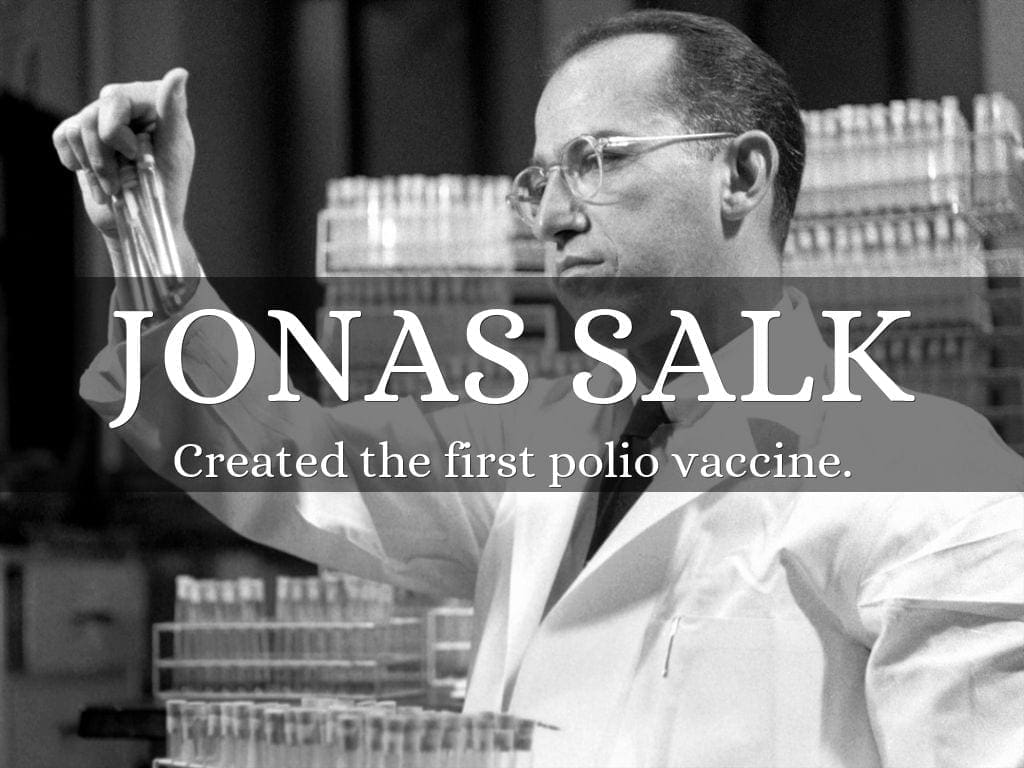
“Risks, I like to say, always pay off. You learn what to do or what not to do” ~ Jonas Salk
Salk developed a passion for studying viruses in medical school.
Jonas Salk reported in 1947, “I was visited by the Director of Research of the National Foundation of Infantile Paralysis, asking if I would be willing to participate in a program typing polio viruses. I had no experience in working with polio, but this provided me with an opportunity… So, I seized upon that opportunity. It gave me a chance to get funds, to get laboratory facilities, get equipment, and to hire a staff, and to build up something that was not there.”
Jonas Salk continued his research after his development of the polio vaccine. In 1963 he founded the Jonas Salk Institute for Biological Studies, an innovative center for medical and scientific research.
5 Random Things About Jonas Salk and the Polio Vaccine
For the first half of the 20th century, polio was the most frightening public health issue in the United States. Unlike recent public health panics over SARS, bird flu, and swine flu, polio actually had a devastating effect on the health of the nation. For example, the polio outbreak in 1952, considered the worst in U.S. history, saw 58,000 cases reported that year, of which 3,145 people died and another 21,269 were left with some form of paralysis. Enter Dr. Jonas Salk, who would change the world forever by creating a vaccine against this dreaded disease. If the good doctor was still living today would be his 96th birthday. In his honor, here are 5 random things about the man that eradicated the mid-20th century’s most dreaded disease.
- Dr. Salk was born on October 28, 1914 to Russian-Jewish immigrants Dora and Daniel Salk. He had 2 brothers, Lee and Herman. Lee would go on to become a clinical psychologist, and Herman a veterinarian. As a child, Jonas had no interest in becoming a doctor, instead wanting to become a lawyer. It was only upon his mother’s insistence that he would be a terrible lawyer that Jonas decided to attend medical school.
- Since he was an exceptional student, Salk skipped multiple grades and became a college freshman at City College of New York at the age of 15. Upon graduation, he attended NYU medical school. In 1942, Salk won a research fellowship at the School of Public Health at the University of Michigan, where he worked on a flu vaccine for the U.S. Army.
- The field trials to test the safety and effectiveness of Salk’s polio vaccine were the largest in history up to that point, involving 20,000 physicians and public health officers, 64,000 school personnel, and 220,000 volunteers, with over 1,800,000 school children participating in the trial.
- The success of the polio vaccine was announced on April 12, 1955; 10 years to the day after the death of the world’s most famous polio victim, Franklin Roosevelt. Within two years, the number of cases of polio dropped by 90% and the last indigenous case of polio in the U.S. was reported in 1991.
- In 1977, Jonas Salk was awarded the Presidential Medal of Freedom, one of the highest civilian awards that the U.S. government can bestow. The accompanying statement read:
“Because of Doctor Jonas E. Salk, our country is free from the cruel epidemics of poliomyelitis that once struck almost yearly. Because of his tireless work, untold hundreds of thousands who might have been crippled are sound in body today. These are Doctor Salk’s true honors, and there is no way to add to them. This Medal of Freedom can only express our gratitude, and our deepest thanks.”
What makes this story truly remarkable, though, was Jonas Salk’s attitude about his work and the results thereafter. For Dr. Salk, this was all in a day’s work, it was never about money or fame. In 1955, on an episode of See it Now, Edward R. Murrow asked, “Who owns this patent?” to which Salk replied, “No one. Could you patent the sun?”

Be the first to comment